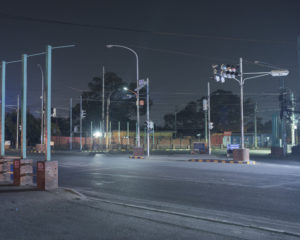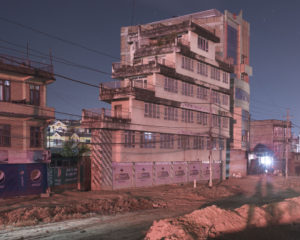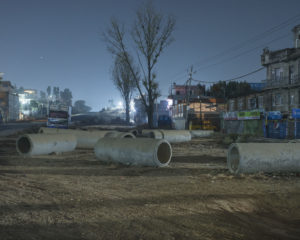SHIFTING VALLEY
As a part of the course we were supposed to work on small assignments at the end of each workshop and 2 final projects, one in Nepal and another in Dhaka. My project from Nepal was titled Shifting Valley. I initially wanted to work on a story around air pollution in Kathmandu, but due to many difficulties, my mentor advised me to change my direction. So I ended up shooting the infrastructural changes in Kathmandu instead. I started to walk along the ring road. It was then that I first shot some of these half constructed structures. I specifically started to search for these structures along the highway. My major resources or sources of information were the residents of Kathmandu themselves. I learnt, how, after the earthquake, the city had started to transition, and so began this series.
Q. How has educationlmentoring changed your practice over time? What were your expectations of the course or workshop you were involved with?
Education has given me a better understanding about the form, my limitations and my boundaries. Knowing the limitations of the medium has helped me understand how I can use other mediums along with photography to communicate and create a better experience for the viewer. Mentorship has given me a direction in the way I approach a story. I was looking for a school which creates an open platform for students to learn and experiment. I wanted to belong to a community. I was very curious to learn about traditional and contemporary practices of photography.
Q. Why is photography the medium of your choice and what are the practical and theoretical challenges you have faced?
I didn’t ‘choose’ photography as my medium of choice. It just happened to be. I was more interested in film making but ended up taking up photography. I don’t want to restrict myself with just one medium.
One of the major challenges that I faced was how my initial idea for this project changed, from shooting air pollution to shooting the infrastructure. I am an outsider in Nepal and I didn’t want to misrepresent the space.
Q. How do you think photography will change in the future and what will be the role of the University/Festival/Workshop in it?
The way we use photography has changed so much. Photographers are working with other mediums like text, video, music etc, and use it to their advantage in communicating emotions. For his exhibition ‘Origins’ in Chobi Mela, Sarker Protick created a light chamber with resonating sound and the images being projected on the wall. It was more of an experience than just communication. There are also photographers who experiment with the content itself. When I was introduced to ‘Shimmer of Possibility’ by Paul Graham, it was an eye opening moment to see someone create a beautiful work by just capturing the simplicity of our daily lives. Photography has become more about who we are and what we want to say.
Universities play a major role in this transition. This allows them to experiment and learn and find their own voice as a photographer. The ultimate goal for any work is to communicate with the audience.
Q. What aspects should be included in photography courses to lend criticality?
No photography school in India offers a short-term course that is fully dedicated for documentary work and story telling. Most of the photography courses in India offer courses only on the commercial aspect of photography. One of the main reasons I decided to join Pathshala was the time-frame of the International Photography Program.
2. Photography courses should impart education about the basics of curation. Learning more about curation and how it creates an impact on the audience can help the students understand more about the medium’s possibilities and its limitations.
3. Photography courses should help students understand and identify their own visual language.
4. Photography courses must conduct meetings and talks with artists from different mediums. This allows the students to meet renowned contemporary artists and understand how they work. Students must build a relationship with other artists and learn from their experience. They must not restrict themselves only to one medium or art form.
5. Each photography school has their own school of thought and their own way of teaching. Photography schools should keep experimenting with their approach and way of teaching. There should be many visiting artists. This would create a more vibrant learning experience.
All images from the series Shifting Valley Nepal, 2016, Digital (Cropped in 4×5 format)

Near Satdobato-Godavari road, Harisiddhi, Nepal Dec 18, 2016

A bizarre footbridge, Thamel, Nepal Dec 20, 2016

A footbridge being constructed, Ring Road, Patan, Nepal, Dec 2, 2016

A house at night with the lights on, Ring Road, Patan, Nepal, Dec 1, 2016

At the Kupondole junction, Nepal, Dec 2, 2016

A strangely constructed building; Dhobighat, Patan, Nepal, Dec 2, 2016

Heavy concrete pipes are being installed on the side of the road, Jhamsikhel, Nepal, Dec 2, 2016

Concrete pillars under the bridge near Bagmati river, Bhalku, Nepal, Dec 1, 2016